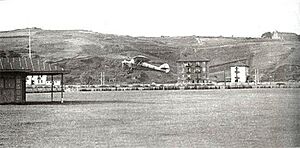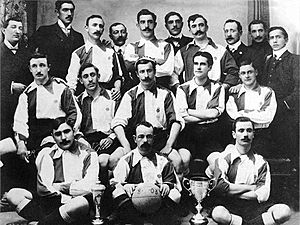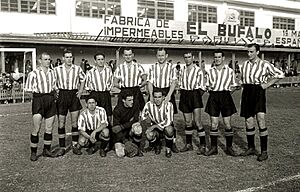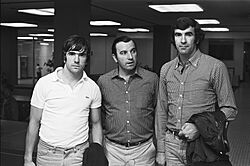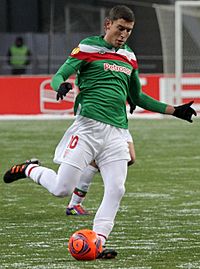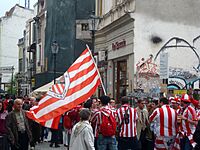History of Athletic Bilbao facts for kids
Athletic Bilbao is a famous Spanish football club from Bilbao, a city in the Basque Country.
This club is special because it only signs players who have a connection to the Basque Country. Even with this rule, Athletic Bilbao is one of only three clubs that have played in every top-tier league season without ever being sent down to a lower division. They have also won many national league titles and domestic cups since they started in the early 1900s.
Contents
- How Football Started in Bilbao
- The Club's Beginning
- The Bizcaya Team
- Early Copa del Rey Wins
- The First La Liga Season
- The Fred Pentland Years
- League Title Under William Garbutt
- Atlético Bilbao Era
- The Javier Clemente Years
- The Luis Fernández Era
- Tough Times and Recovery
- The Marcelo Bielsa Era
- The Ernesto Valverde Era
- The Ziganda Era
- See also
How Football Started in Bilbao
Football came to Bilbao in two main ways. First, British workers from steel and shipyard companies brought the game with them. Second, Basque students who had studied in Britain returned home with a love for football.
In the late 1800s, Bilbao was a busy port with many industries. British workers formed a sports club and played the first known football match in Bilbao in 1890. They often played against crews from English ships. These early games were held at a place called Lamiako, where many local people came to watch. Soon, the local people started playing too.
At the same time, young Basque students who had studied in the United Kingdom became interested in football. When they came back to Bilbao, they also started organizing games at Lamiako. Even when they lost to the British players, they loved the sport and kept playing.
The Club's Beginning
In 1898, a group of Basque football fans, led by Juan Astorquia, decided to create a place to practice football at Lamiako. This group would later become Athletic Bilbao. They started playing matches against the British workers every Sunday.
A few years later, in 1900, another group of young people from Bilbao, who had also studied in England, founded the Bilbao Football Club. Seeing this, the Lamiako group decided to officially form their own club. In 1901, they officially established "Athletic Club," using the English spelling. They chose this name because "Bilbao Football Club" was already taken.
In 1902, Juan Astorquia became the club's second president. There is some debate about the exact founding year of Athletic Bilbao, with some saying 1898, others 1901, and some even 1903 when Athletic merged with Bilbao Football Club.
The Bizcaya Team
By the end of 1901, Athletic Club and Bilbao FC were the two main football teams in the city. They became rivals, playing friendly matches at Lamiako. Despite their rivalry, they had a good relationship.
In 1902, the two clubs decided to combine their best players to form a temporary team called Club Bizcaya. This team played two games against a French team from Bordeaux. Bizcaya won both games, including a 7-0 victory in Bilbao, which was the first time a foreign team visited the city.
Club Bizcaya also played in the 1902 Copa de la Coronación, which was the first version of the Copa del Rey. They won the trophy, beating FC Barcelona 2-1 in the final. After this success, Bilbao FC and Athletic Club decided to officially merge on March 24, 1903. The new combined team was called Athletic Club de Bilbao.
Early Copa del Rey Wins
Athletic Bilbao became very successful in the early Copa del Rey competitions. After the Club Bizcaya win in 1902, the newly merged Athletic Bilbao won the cup again in 1903. They beat Real Madrid 3-2 in the final. In 1904, they won by default because their opponents did not show up.
After a short break, they won the cup again in 1911. In 1913, the club opened its new home, the San Mamés Stadium. This stadium became a symbol of Athletic's strength in the 1910s. They won the Copa del Rey three times in a row between 1914 and 1916.
A famous player from this time was Pichichi, a great goalscorer. He scored the very first goal at the San Mamés stadium in 1913. He also scored three goals in the 1915 final. Sadly, he died young at 29. Today, the award for the top scorer in La Liga is called the Pichichi Trophy in his honor. Athletic won the cup again in 1921.
The First La Liga Season
In 1920, when Spain's national football team played its first international games at the Olympics, Athletic Bilbao had three players on the squad. These players helped Spain win a bronze medal.
Athletic Bilbao was one of the founding members of La Liga, Spain's national league, which started in 1928. By 1930, five of the ten teams in the top division were from the Basque Country. This showed how strong Basque football was, and it supported the saying: "With home-grown teams and supporters, there is no need for imports."
The Fred Pentland Years
In 1921, a new British coach named Fred Pentland joined Athletic Bilbao. In 1923, he led the club to another Copa del Rey victory. Pentland changed how Athletic played, focusing on short passes.
He left for a few years but returned in 1929. Under his leadership, Athletic won both La Liga and the Copa del Rey in 1930 and 1931. The club won the Copa del Rey four times in a row between 1930 and 1933. They also finished second in La Liga in 1932 and 1933. In 1931, Athletic famously beat Barcelona 12-1, which is still Barcelona's worst-ever defeat.
League Title Under William Garbutt
British coaches continued to bring success to Athletic. William Garbutt arrived in 1935. He was a respected coach who had won titles in Italy. In his first season, he led Athletic to win the La Liga title in 1936.
Garbutt helped make an already strong team even better. He brought young player Ángel Zubieta into the first team, who became the youngest player to play for Spain at that time. Athletic won the title by just two points over Real Madrid. However, football stopped in Spain in July 1936 due to the Spanish Civil War. The league did not start again until 1939.
Atlético Bilbao Era
In 1941, the club had to change its name to Atlético Bilbao because of a government rule that banned non-Spanish names. During this time, a legendary player named Telmo Zarra joined the team. Over 13 seasons, he scored 294 goals for the club. His record of 38 goals in a single season stood for 60 years.
In 1943, the club won both the league and the cup (then called Copa del Generalisimo). They won the cup again in 1944 and 1945. In the early 1950s, the team had a famous group of forwards, including Zarra, who helped them win another cup in 1950.
With coach Ferdinand Daučík, the club won another league and cup double in 1956, and more cups in 1955 and 1958. In 1956, Athletic also played in the European Cup for the first time.
During the 1930s, 1940s, and 1950s, rules limited the number of foreign players clubs could have. This helped Athletic succeed because they stuck to their policy of using local players. However, in the 1960s, Real Madrid dominated, and Athletic only won one Copa del Rey in 1969. The 1960s also saw the rise of a club legend, goalkeeper José Ángel Iribar.
The 1970s were also tough, with only one Copa del Rey win in 1973. In 1976, Iribar and the captain of Real Sociedad bravely carried the Basque flag onto the field before a game. This was the first time the flag was shown publicly since the end of a strict government rule. In 1977, the club reached the UEFA Cup final but lost. After this, the club went back to using its original name, Athletic.
The Javier Clemente Years
In 1981, Javier Clemente became the manager. He built one of the most successful Athletic Bilbao teams ever. Young players joined experienced ones. In 1983, the club won La Liga. In 1984, they won both La Liga and the Copa del Rey. This was a "double" win.
Clemente's teams were known for their aggressive style of play. Since this successful period, Athletic has not won a major trophy. Many coaches have tried, but none have repeated Clemente's success.
The Luis Fernández Era
One of the most successful coaches after Clemente was Luis Fernández, who joined in 1996. In 1998, he led the club to second place in La Liga, which meant they qualified for the UEFA Champions League.
During this time, Athletic became a bit more flexible with its player policy. Players could play for Athletic if they had learned their football skills in the Basque Country, even if they weren't born there. This allowed players from other regions or even other countries (who moved to the Basque Country young) to join.
Fernández signed players like Bixente Lizarazu, the first French-born Basque to join, and others who had trained in different academies. Athletic also started recruiting players from other Basque clubs' youth teams. In 1998, Athletic played against the Brazil national team to celebrate the club's 100th anniversary.
Tough Times and Recovery
After some changes in coaches, the club faced difficult times in the 2005-06 and 2006-07 seasons, fighting to avoid being relegated from the top league. Javier Clemente returned as coach in 2005 and helped the team stay in the top division.
In the 2008-09 season, Athletic finished in the middle of the league table. However, they had a great run in the Copa del Rey, reaching their first final in 24 years. They lost 4-1 to Barcelona in the final, but this earned them a spot in the UEFA Europa League for the next season.
The 2009-10 season saw steady progress in the league and Europe. Young stars like Javi Martínez, Markel Susaeta, and Óscar de Marcos played well. A very young Iker Muniain also made a successful start. In the 2010-11 season, Athletic qualified for the Europa League again.
The Marcelo Bielsa Era
Before the 2011-12 season, a new president, Josu Urrutia, was elected. He promised to bring in Marcelo Bielsa, a famous coach from Argentina. Bielsa was known for his unique formations and tactics.
The team started slowly, but players began to adapt. They had a strong run in the Europa League, winning their group. They then beat big teams like Manchester United, winning both games against them. In the quarter-finals, they beat Schalke 04 from Germany. They then defeated Sporting CP in the semi-finals to reach the final.
In their first European final since 1977, Athletic lost 3-0 to fellow Spanish club Atlético Madrid in Bucharest. Despite this disappointment, they had another chance for a trophy in the 2012 Copa del Rey final. However, they lost 3-0 to Barcelona again. Being cup runners-up still meant they qualified for the Europa League.
The 2012-13 season was a bit difficult. Some top players, like Fernando Llorente and Javi Martínez, wanted to leave for clubs that offered higher wages. Javi Martínez eventually joined Bayern Munich. The team's results were not good, and they were knocked out of the Europa League and Copa del Rey early. They also played their last league game at the "old" San Mamés stadium.
The Ernesto Valverde Era
After Marcelo Bielsa left, Athletic brought back former player Ernesto Valverde as manager. They signed new players like Beñat Etxebarria and defenders Xabier Etxeita and Mikel Balenziaga. They also signed striker Kike Sola to play alongside Aritz Aduriz. Young players like Aymeric Laporte also became important.
The 2013-14 season was very successful. Athletic finished fourth in the league, which meant they qualified for the UEFA Champions League. Stars like Aritz Aduriz and Ander Herrera played exceptionally well. Herrera later joined Manchester United.
In the 2014-15 season, Athletic played their first full-capacity match in the new San Mamés stadium, beating Napoli to qualify for the Champions League group stage. They reached the Copa del Rey final again but lost to Barcelona once more.
In the 2015-16 season, Athletic made history by defeating Barcelona 4-0 in the first leg of the Spanish Super Cup, with Aritz Aduriz scoring three goals. They drew the second leg 1-1 to win their first trophy since 1984! Aduriz continued to score many goals that season. The team finished fifth in the league and reached the Europa League quarter-finals.
The 2016-17 season saw good results, especially at home. Young players Yeray Álvarez and Kepa Arrizabalaga became key members of the team. Athletic finished seventh in the league. They were knocked out of the Copa del Rey by Barcelona again. In the Europa League, Aduriz scored all five goals in a 5-3 home win against Genk, a competition record. At the end of the season, Ernesto Valverde left the club and was replaced by former player José Ángel Ziganda.
The Ziganda Era
Ziganda's time as coach began with Europa League qualifying matches. Athletic successfully reached the group stage. However, in the Copa del Rey, the club suffered a surprising defeat to a lower-division team, SD Formentera, losing in the final moments of the game.
See also


